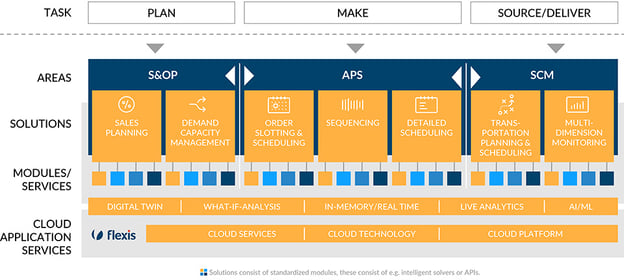How To Make The Most Out Of Multimodal Transportation: Case Study
Keith LaBotz - December 08, 2022

Multimodal shipping expands a shipper’s options for improving transportation efficiency, sustainability, and customer service. But multimodal planning and execution can get complicated, preventing many companies from making the most of these opportunities.
That is what a leading kitchen manufacturer in Germany discovered when it saw an opportunity to revise its existing multimodal strategy. The gains were within reach, but they lacked the technology to access them, and that’s where flexis AG was able to help. The results were nothing short of remarkable.
With a private fleet of over 200 trucks providing a white glove delivery service throughout Europe for their exclusive product line, logistics is a core competency for this kitchen company. They understand reliable delivery is critical for their success and view transportation as a strategic asset.
The company’s fleet of trucks displaying its logo and the company drivers reinforce the brand’s reputation for top-notch customer service. Their customers are receiving their dream kitchens and have high expectations for the delivery experience. Delivery is too important to outsource to third-party logistics providers.
Record-high inflation and fuel prices increased pressure to reduce delivery costs without sacrificing service quality. That put a spotlight on optimizing transportation planning and routing.
At the same time, a chronic driver shortage made finding and retaining the best drivers more challenging. They began considering improvements to make the transportation process more attractive to drivers.
Reducing carbon emissions from supply chain transportation was also a priority. EVs are not viable for this company’s distribution scenario, but improved transportation planning could minimize the number of vehicles and miles driven.
Resolving these challenges required end-to-end transportation optimization considering multiple transport modalities: long-haul trucking, rail services, and daily vehicle routing and scheduling (VRS) process. Finding such a solution proved more difficult than expected.
Let’s examine the requirements and concerns of a leading kitchen manufacturer to understand how flexis can help your company to make the most of multimodal transportation opportunities.
The Original Multimodal Process
The kitchen builder began searching for a solution to provide end-to-end transportation optimization for their distribution scenario in Italy, where they would pilot their new multimodal strategy.
The original intermodal shipping operation was a simple truck and rail combination that delivered kitchens to customers in Italy.
-
The factory in Germany shipped 15 trailers of orders by train to Italy each week.
-
Fifteen tractors drove from Germany to pick up their trailers at the train station in Italy.
-
Each driver would haul their empty trailer back to the factory in Germany.
Requirements for The Improved Multimodal Process
-
Planning must be fully automated and work with “the push of a button.”
-
A reduction in shipping costs could never come at the expense of service quality.
-
Tours and stops had to optimize for changing conditions, so delivery plans minimized transportation miles and transit time and fully utilized capacity.
-
The most fuel-efficient combination of modes would need to be selected for each leg to minimize costs for variable constraints, including order volumes, driver availability, vehicle capacity, ours of service rules, train schedules, and area served.
-
The planning process would optimize tours and train schedules for multiple days.
-
A chronic driver shortage in Europe made attracting the best drivers a priority. The process needed to facilitate a frustration-free driver work experience and engender positive customer interactions. Additionally, planning had to ensure drivers returned home when expected.
-
Driver tours had to coordinate the variability of daily train schedules - trains do not arrive and depart the station in Italy at a consistent time each day.
-
Shuttles in Germany needed to get the trailers from my factory to the train station.
-
The system must schedule the loading of empty trailers onto trains in Italy for return to the factory in Germany.
flexis Answers Complicated Questions with Evidence
 |
Robert Recknagel, VP of Logistics flexis AG |
Robert Recknagel, VP of Logistics flexis AG, met with their logistics team to explore the requirement in greater detail. They had many questions:
- “Why do we need to drive down to Italy with 15 trucks a week?”
- “Why can't we drive five trucks to Italy and ship the remaining ten trailers by train to Italy? With five trucks already delivering orders in Italy, why can’t our drivers pick up the remaining trailers at the train station and deliver them the week?”
- “Can flexis provide a planning process that begins with the driver leaving for Italy on Sunday night and ensures he returns home on Friday evening?”
- “We know there’s enough volume for 15 trailers, but what is the least number of trucks needed to deliver these trailers?
Answering these questions was impossible without an extensive “what-if” analysis of their shipping history. Determining the optimal mix of vehicles and train schedules would require evaluating countless transportation modes, train schedules, and routes.
The shipper provided flexis with historical shipping data, and flexis’ transportation planning solution analyzed various multi-modal arrangements. With the results in hand, Recknagel could answer the shipper’s questions with cost scenarios calculated from actual shipping patterns.
Recknagel’s analysis also demonstrated that the shipper could use the same transportation planning solution to formulate a multimodal strategy and update it as future requirements change.
How flexis Makes Multimodal Opportunities Available
The Requirement: Formulating an effective multimodal strategy requires an all-inclusive, end-to-end transportation optimization. In the case of the kitchen manufacturer, analyzing all legs of transportation to and from Italy: long-haul trucking, train schedules, and the daily delivery tours for each vehicle.
The Problem: TMS and VRS solutions typically coexist in separate functional silos, transportation planning may partially overlap them, and transportation execution usually disconnects from supply chain management (SCM). The point is that most shippers operate with fragmented transportation processes. A fragmented transportation process cannot support all-inclusive, end-to-end optimization of transportation.
The Solution: The flexis suite of apps solves the problem above by integrating S&OP, APS, and SCM (logistics) planning and execution with the TMS and VRS processes. With this in place, a company can formulate a multimodal strategy and incorporate it into transportation planning and execution.

New Operational Scenario
The solution proposed by flexis reduces the number of trucks servicing Italy from 15 to 5 - a reduction of 66%. Here’s a description of the new process:

-
Day 1: The truck driver picks up a trailer from the factory loaded with four or five deliveries. The driver heads to Italy to deliver these kitchens.
-
Day 2 - 4: When the driver has completed the first tour, he heads to the train station to drop off the empty trailer and swaps it for the next trailer loaded for the second tour. The trailer swap is repeated each day for subsequent trailers until orders in the final trailer are delivered.
-
Day 5: When the driver has completed the final tour of the week, he drives back to his home in Germany with the empty trailer instead of swapping it at the train station.
-
Empty trailers dropped off at the train station return to Germany, where a waiting shuttle delivers them to the factory.
-
The factory reloads the empty trailers for the next week of deliveries, and the cycle repeats for the new week.
Conclusion
Multimodal transportation offers significant opportunities for shippers. Making the most of these requires digital solutions that support end-to-end transportation optimization. flexis provides the software and services needed solution to formulate a multimodal strategy and update it as future requirements change.
If you want to learn more get your Guide to Logistics 4.0
In this Guide you will learn:
-
Why a strategic process in transportation planning is a top priority for digitalization
-
What megatrends will increase supply chain volatility
-
How to manage it
Want to learn more about Multimodal Transportation?
Download our presentation and learn:
-
How can transports be planned quickly and yet flexible so that CO2 savings are verifiable?
-
How do you make optimal use of a multimodal transport network that maintains supply in both the short and long term?
-
How can you more easily realize a modal shift when disruptions occur? And how do you keep a grip on your CO2 emissions in doing so?
flexis and BigMile present a Use Case of a modal shift and show that network optimizations and sustainability often go hand in hand.
LATEST POSTS
- Understand Circular Economy in The Manufacturing Industry
- How Can Industry 4.0 IT Integration Be Achieved Smoothly?
- The Significance of Order Sequencing in Discrete Manufacturing
- How to improve your Supply Chain Management: The Power of Control Towers
- Optimizing Human Resource Scheduling in Manufacturing: A Technological Approach




